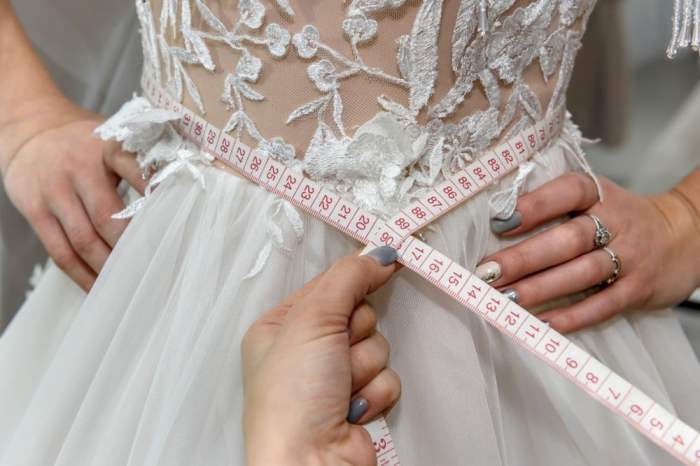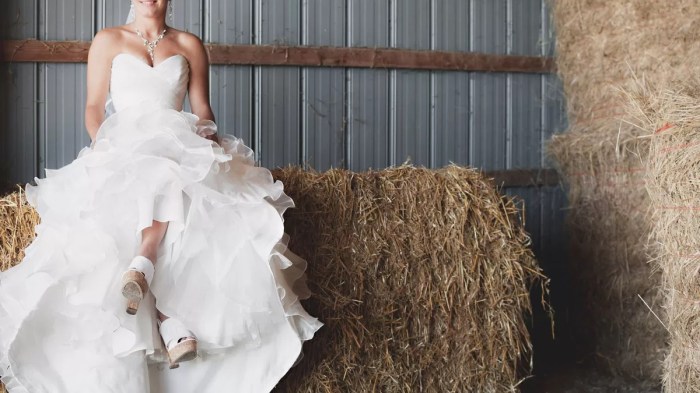Enlarging a Wedding Dress: Methods and Considerations

Source: yeahweddings.com
Can you make a wedding dress bigger – Altering a wedding dress to accommodate a larger size requires careful planning and execution. Several techniques can be employed, each with its own advantages and challenges depending on the dress’s design and fabric. This guide Artikels the various methods, materials, and considerations involved in successfully increasing the size of a wedding gown.
Methods for Increasing Wedding Dress Size, Can you make a wedding dress bigger

Source: bridilly.com
Several techniques exist for enlarging a wedding dress. The most common include letting out seams, adding fabric panels, and inserting darts. The suitability of each method depends on the dress’s construction, fabric type, and the amount of size increase needed.
- Letting Out Seams: This involves carefully releasing existing seams to add extra width or length. This is generally the least expensive method, but it’s limited by the amount of seam allowance available. A step-by-step guide is provided below.
- Adding Fabric Panels: This involves inserting additional fabric panels into the seams or side panels of the dress. This is a more versatile method, allowing for larger size increases, but requires careful matching of fabric and pattern.
- Inserting Darts: Darts can be let out or added to adjust the fit of the bodice or skirt. This is a more intricate technique best suited for experienced seamstresses.
Step-by-Step Guide to Letting Out Seams
- Carefully examine the seams, noting the stitching and the amount of seam allowance available.
- Using a seam ripper, gently remove the stitching, working slowly to avoid damaging the fabric.
- Press the seam allowances open to create a clean, flat surface.
- Assess the additional space created. If insufficient, consider adding fabric panels.
- Re-stitch the seam, ensuring even spacing and a professional finish.
Fabric Suitability for Alterations
Different fabrics react differently to alterations. Some are more forgiving than others. Factors such as stretch, drape, and weave density influence the outcome.
- Silk: Delicate and prone to snagging. Requires careful handling and may not be suitable for extensive alterations.
- Lace: Can be challenging to alter due to its intricate design. Requires specialized techniques to avoid damage.
- Tulle: Relatively easy to alter and can be easily added to or removed.
- Satin: Smooth and lustrous, but can be difficult to match if panels need to be added.
Cost-Effectiveness of Alteration Methods
| Method | Cost (Estimate) | Suitability | Difficulty |
|---|---|---|---|
| Letting Out Seams | $50-$150 | Small size increases | Easy-Moderate |
| Adding Fabric Panels | $150-$300+ | Larger size increases | Moderate-Difficult |
| Inserting Darts | $100-$250+ | Bodice and skirt adjustments | Moderate-Difficult |
Assessing the Wedding Dress for Alterations
Before attempting any alterations, a thorough assessment of the wedding dress is crucial. This involves evaluating its design, fabric, construction, and any delicate details.
- Design Evaluation: Consider the dress’s silhouette, construction details (e.g., seams, darts, boning), and the amount of fabric available for alterations.
- Fabric Assessment: Evaluate the fabric’s type, drape, stretch, and its suitability for the chosen alteration method. Identify any areas that are delicate or prone to damage.
- Detail Inspection: Check for beading, embroidery, sequins, or other embellishments that may be affected by alterations. These details may require specialized handling or may limit the alteration options.
Wedding Dress Alteration Checklist
This checklist aids in the pre-alteration assessment:
- Measure the dress accurately.
- Identify the areas needing alteration.
- Assess seam allowances.
- Check for fabric suitability.
- Inspect for delicate details.
- Note any limitations or challenges.
Materials and Tools Required for Alterations
Gathering the necessary materials and tools is essential for successful alterations. The specific requirements depend on the chosen alteration method and the dress’s fabric.
- Thread: Choose a high-quality thread that matches the dress’s fabric color and weight. Test the thread on a hidden area to ensure color matching and prevent any damage.
- Needles: Select needles appropriate for the fabric type. Fine needles are suitable for delicate fabrics, while heavier needles are needed for thicker materials.
- Interfacing: Interfacing provides support and stability to seams and prevents stretching. Choose a type that complements the wedding dress fabric (e.g., lightweight fusible interfacing for delicate fabrics).
- Seam Ripper: A sharp seam ripper is essential for carefully removing existing stitching.
- Measuring Tape: Accurate measurements are crucial for successful alterations.
- Pins: Use pins to hold fabric in place during alterations.
- Scissors: Sharp scissors are essential for precise cutting.
- Iron and Ironing Board: Pressing is crucial for achieving a professional finish.
Professional vs. DIY Alterations
Deciding between professional and DIY alterations depends on your sewing skills, the complexity of the alteration, and your budget.
- Professional Alterations: Offer expertise, precision, and a guarantee of quality. Costs vary depending on the complexity of the alteration and the tailor’s rates.
- DIY Alterations: Can be cost-effective, but require sewing skills and experience. Errors can be difficult to correct.
Factors Influencing Professional Alteration Costs
Professional alteration costs depend on factors such as the complexity of the alterations, the type of fabric, the amount of work required, and the tailor’s experience and location.
Situations Requiring Professional Help
Professional help is essential for intricate alterations, such as those involving delicate fabrics, complex designs, or extensive modifications. It is also advisable for alterations to vintage or high-value wedding dresses.
Finding a Reputable Seamstress
Seek recommendations from friends, family, or bridal shops. Check online reviews and consider visiting several seamstresses for consultations before making a decision.
Visual Examples of Successful Alterations
Several successful alterations demonstrate the versatility of techniques. For example, a fitted A-line gown made of satin could have its side seams let out to accommodate a larger bust and waist. A ballgown with a lace bodice and tulle skirt might require adding lace panels to the bodice and tulle panels to the skirt. A mermaid gown with intricate beading may need careful adjustments to the seams and darts, ensuring that the beading remains intact and evenly distributed.
In each case, careful planning and execution are essential to maintain the dress’s integrity and aesthetic appeal. Before and after comparisons would highlight the changes to the bodice, skirt, and other components, showcasing the successful size increase while preserving the overall design and style.
FAQ Resource: Can You Make A Wedding Dress Bigger
What if the dress is heavily beaded or embroidered?
Altering a heavily embellished dress requires extra care and often necessitates professional expertise to avoid damage to the delicate details. The cost will likely be higher.
How much does it typically cost to have a wedding dress professionally altered?
The cost varies greatly depending on the extent of alterations, the complexity of the dress, and the tailor’s location and experience. Expect to pay anywhere from a few hundred to several thousand dollars.
Can I let out seams on all types of wedding dress fabrics?
No. Some fabrics, such as delicate lace or heavily structured materials, may not have enough seam allowance to let out or may be prone to damage if altered.
Altering a wedding dress to make it larger is definitely possible, depending on the design and fabric. For instance, if you’re considering a more relaxed style, you might find inspiration in the flowing silhouettes of a boho wedding dress no train , which often have more room for adjustments. Ultimately, the feasibility of enlarging a dress will depend on its construction and the expertise of the seamstress.
What if I’m unsure if I can alter the dress myself?
If you’re uncertain about your sewing skills or the complexity of the alterations, it’s best to consult a professional seamstress or tailor. They can assess the dress and advise on the feasibility and cost of the alterations.
